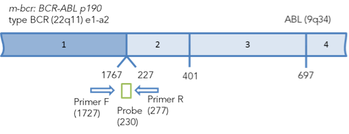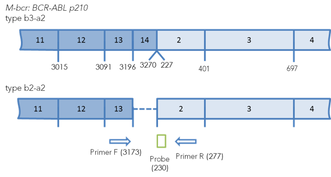Kit for detection and quantification of mRNA of the chimeric BCR-ABL Mbcr transcript and mRNA of the ABL gene in clinical material by polymerase chain reaction (PCR) with real-time hybridization-fluorescence detection.
The kit can be used to detect cases of CML associated with the Philadelphia chromosome, to confirm the diagnosis of CML and to monitor the efficiency of therapy by quantitative assessment of minimal residual disease (MRD).
The kit of reagents is designed to conduct a study in a real-time format for 24 clinical samples in duplicate (a total of 132 PCR reactions, including controls).
The chimeric BCR-ABL gene results from rearrangement of the long arms of chromosomes 9 and 22, microscopically seen as the so-called Philadelphia chromosome (t(9;22), Ph). This translocation is characteristic of chronic myeloid leukemia (CML) and acute lymphoblastic leukemia (ALL), and also occurs in acute myeloid leukemia (AML). The chimeric BCR-AB1 gene encodes a fusion protein showing very high tyrosine kinase activity which plays a key role in the development of leukemia. There are several variants of the BCR-ABL gene transcripts that are characteristic of distinct leukemia types. Thus, CML is predominantly characterized by b3a2 and b2a2 transcripts, leading to the formation of a protein with a molecular weight of 210 kDa (p210 transcripts, Mbcr), while most children with Ph+ ALL have a chimeric e1a2 transcript encoding a protein with a molecular weight of 190 kDa ( p190 transcripts, mbcr). Both BCR-ABL mbcr and BCR-AB1 Mbcr transcripts are also found in a number of adult ALL patients.


Figure 1. Scheme of formation of chimeric BCR-ABL transcripts b3a2, b2a3 and e1a2. The binding sites of primers and probes for real-time PCR are marked. The positions of primers and probes are indicated relative to the 5' end of the nucleotide sequences of normal transcripts.
The use of real-time PCR (Real-Time Quantitative PCR, RQ-PCR) to assess the level of BCR-ABL chimeric transcript expression in the studied cells makes it possible to achieve a significantly higher sensitivity in assessing minimal residual disease (MRD), detecting one leukemic cell per 50,000 normal leukocytes.
More detailed information on diagnostic approaches, frequency of the study and prognostic value of this testing in leukemias are available on the website of the International Network European Leukemia Net (http://www.leukemia-net.org).
Ordering information:
BCR-ABL1 Mbcr RQ Kit (b2a2, b3a2 transcripts, p210), 24 tests Cat.No IG-RQ-1-24
BCR-ABL1 Mbcr RQ Kit (b2a2, b3a2 transcripts, p210), 48 tests Cat.No IG-RQ-1-48
Additiional reagents:
Blood RNA stabilizer medium Cat.No IG-RSB-100
TriZ Reagent Kit Cat.No IG-TRK-100
ReverZyme Kit Cat.No IG-RT-1
Erythrocyte Lysis Solution Cat.No IG-TRL-100
Price: on request
Reagents are for research use only (RUO)